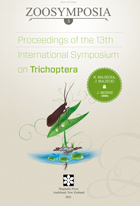Abstract
Trichoptera is a widely distributed and diversified group in Andean Patagonia (Subandean Patagonic Province). This group exhibits a wide array of functional adaptations to exploit the available food resources. It is well known that changes in the relative abundance of functional-feeding groups (FFG) occur when the distribution of energetic resources (organic matter) is altered. In order to determine the functional structure variation among rivers subjected to different land uses, we selected 3 disturbance types (exotic plantation, pasture and logging) and native forest as reference. Three sites were assessed for each land use type (n=12) seasonally (every 3 months) and 6 samples with a Surber net (0.09 m-2 and 250 pore size) were taken. Larvae obtained were identified to the lowest possible taxonomic level, counted and assigned to a FFG using available references, knowledge of feeding modes and analysis of gut contents. A total of 32 taxa were identified belonging to 11 families. Mean annual densities of Trichoptera varied between 131 and 4231 ind.m-2. Pasture sites showed significantly higher density than pine and native forest sites. Overall Trichoptera FFG species composition was: shredder (10), predator (9), scraper (6), collector-filterer (5), algal-piercer (1), and collector-gatherer (1). The scraper Mastigoptila sp. was abundant in native forest rivers. Predators presented high density in logged forest sites. Shredders (53–98%) dominated rivers having dense forest cover; Parasericostoma ovale (Schmid) and Myotrichia murina Schmid (Sericostomatidae) being the most abundant species. Collector-filterers, mostly Smicridea annulicornis (Blanchard) and S. frequens (Navás) (Hydropsychidae), were the dominant group in pastures (42-96%), probably due to an increase of transported seston. According to these results, Trichoptera communities can be used as an early warning tool to assess changes in disturbed headwater systems in Patagonia.

